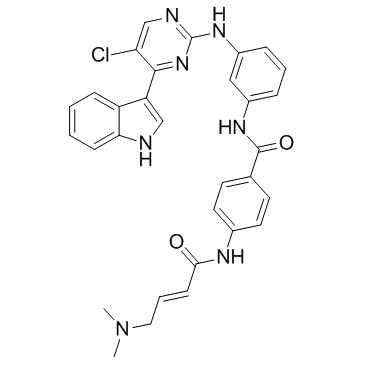1604810-83-4
| Name | N-[3-[[5-Chloro-4-(1H-indol-3-yl)-2-pyrimidinyl]amino]phenyl]-4-[[(2E)-4-(dimethylamino)-1-oxo-2-buten-1-yl]amino]benzamide |
|---|---|
| Synonyms |
Benzamide, N-[3-[[5-chloro-4-(1H-indol-3-yl)-2-pyrimidinyl]amino]phenyl]-4-[[(2E)-4-(dimethylamino)-1-oxo-2-buten-1-yl]amino]-
N-(3-{[5-Chloro-4-(1H-indol-3-yl)-2-pyrimidinyl]amino}phenyl)-4-{[(2E)-4-(dimethylamino)-2-butenoyl]amino}benzamide THZ1 |
| Description | THZ1 is a selective and potent covalent CDK7 inhibitor with an IC50 of 3.2 nM. |
|---|---|
| Related Catalog | |
| Target |
CDK7:3.2 nM (IC50) |
| In Vitro | THZ1 inhibits Jurkat cell and Loucy cell with IC50 of 50 nM, and 0.55 nM, respectively. THZ1 demonstrates time-dependent inhibition of CDK7 in vitro and covalent binding of intracellular CDK7. THZ1 (9, 27, 83, 250, 750, and 2500 nM) inhibits CDK12 but at higher concentrations compared to CDK7. THZ1 (1 μM) irreversibly inhibits RNAPII CTD and CAK phosphorylation. THZ1 (2.5 µM) irreversibly inhibits RNAPII CTD phosphorylation by covalently targeting a unique cysteine located outside the kinase domain of CDK7 in Hela S3 cells. THZ1 (250 nM) causes decreased cellular proliferation and an increase in apoptotic index with concomitant reduction in anti-apoptotic proteins, most notably MCL-1 and XIAP in T-ALL cell lines[1]. Low-dose THZ1 (50 nM) treatment causes selective inhibition of a number of oncogenic transcripts in oesophageal squamous cell carcinoma (OSCC)[2]. All genotypically-distinct human (hSCLC) cell lines exhibit high sensitivity to THZ1, with an IC50 in the range of 5-20 nM[3]. |
| In Vivo | THZ1 (10 mg/kg) demonstrates potent killing of primary chronic lymphocytic leukemia (CLL) cells and anti-proliferative activity against primary TALL cells and in vivo against a human T-ALL xenograft[1].THZ1 (10 mg/kg, i.p.) completely suppresses oesophageal squamous cell carcinoma tumour growth in vivo without loss of body weight or other common toxic effects[2]. THZ1 (10 mg/kg, i.v.) inhibits tumor growth in a mouse model of human MYCN-amplified NB and shows no toxicity[4]. |
| Kinase Assay | For kinase assays following immunoprecipitation of FLAG-CDK7 protein from HCT116 or FLAG-CDK12 from 293A cellular lysates, cells are first treated with THZ1, THZ1-R, or DMSO for 4 hrs at 37°C. Cells are then harvested by lysis in 50 mM Tris HCl pH 8.0, 150 mM NaCl, 1% NP-40, 5 mM EDTA, and protease/phosphatase cocktails. Exogenous CDK7 or CDK12 proteins are immunoprecipitated from cellular lysates using FLAG antibody- conjugated agarose beads. Precipitated proteins are washed with lysis buffer 6 times, followed by 2 washes with kinase buffer (40 mM Hepes pH 7.5, 150 mM NaCl, 10 mM MgCl2, 5% glycerol) and subjected to in vitro kinase assays at 30°C for 45 minutes using 1 μg of the large subunit of RNAPII (RPB1) as substrate and 25 μM ATP and 10 μCi of 32P ATP. Kinase assays using recombinant CDK7/TFIIH/MAT1 are conducted in the manner as described above using 25 ng of CAK complex per reaction. For kinase assays designed to test time-dependent inactivation of CDK7 kinase activity, CAK complex is pre-incubated with indicated concentrations of THZ1, THZ1-R, or DMSO in kinase buffer without ATP for 4 hrs at 30°C prior to being subjected to kinase assay conditions[1]. |
| Cell Assay | Jurkat, Loucy, KOPTK1, and DND-41 cell lines are seeded in 384-well microplates at 15% confluency in medium with 5% FBS and penicillin/streptavidin. Cells are treated with THZ1 (2, 10, 50, 250, 1250, and 6250 nM) or DMSO for 72 hrs and cell viability is determined using resazurin[1]. |
| Animal Admin | Mice[1] Thirty-two NOD-SCIDIL2Rcγnull (NSG) 9-week old female mice are divided into treatment groups based on mean BLI as follows: THZ1 10 mg/kg qD, THZ1 10 mg/kg BID, and vehicle (10% DMSO in D5W) BID (n=10 for all groups). Two mice are excluded, one with the highest and one with the lowest BLI. All treatments are administered via IV injection in the lateral tail vein in a volume of 3.3 μL/g (non-blinded). Mice are imaged and weighed every 3-5 days. Mice are treated for four weeks and on the final day mice are imaged, dosed and sacrificed approximately 5-6 hrs post dose. Upon sacrifice, blood is collected via cardiac puncture in EDTA tubes; a portion (300 uL) is processed for plasma. Liver and spleen tissues are collected from each mouse with half of each sample flash frozen and half of each sample fixed. Blood plasma and liver samples are processed for pharmacokinetics analysis of THZ1. Spleen tissues are homogenized and lysed and processed for pharmacodynamics analysis of THZ1 target engagement. |
| References |
| Density | 1.4±0.1 g/cm3 |
|---|---|
| Molecular Formula | C31H28ClN7O2 |
| Molecular Weight | 566.053 |
| Exact Mass | 565.199280 |
| LogP | 5.08 |
| Index of Refraction | 1.735 |
| Storage condition | -20℃ |
